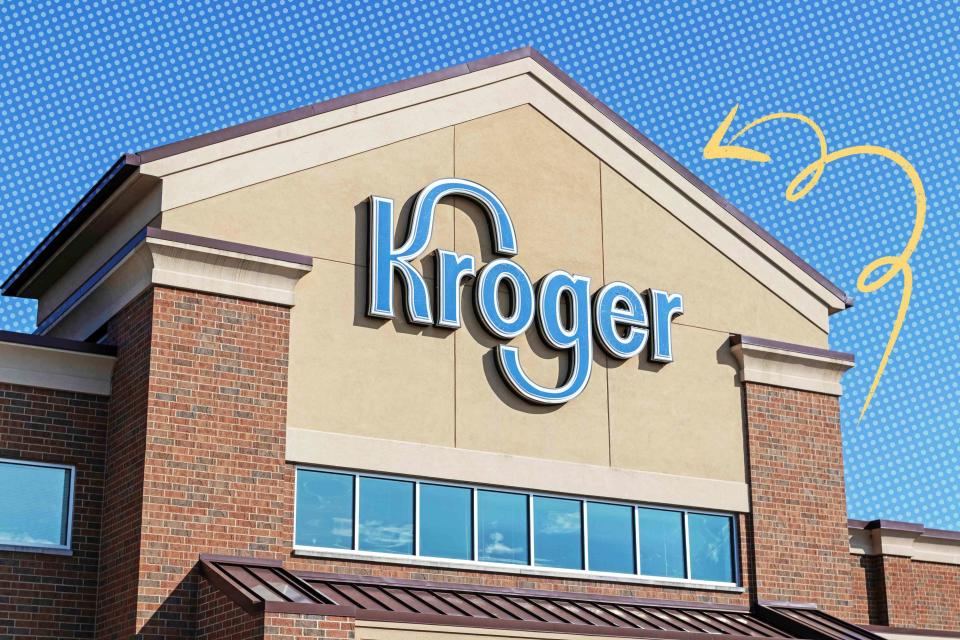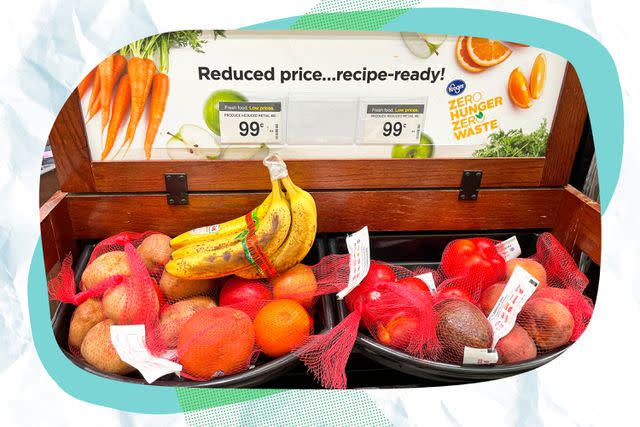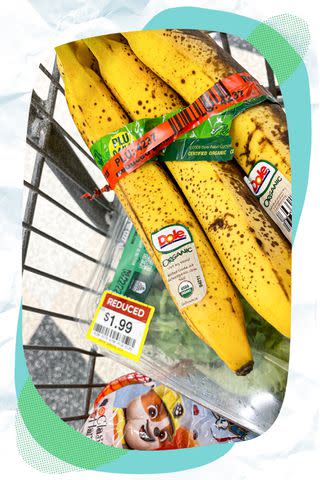The Best Way To Save on Groceries at Kroger, According to a Food Editor
Plus, tips for picking out the good stuff.

Simply Recipes / Adobe Stock
Does it feel like you’re paying more but getting less food out of it these days? I can’t help but do a double-take when I see the total cost of my grocery haul for the week.
So I’m pulling up my sleeves and relying on some of the savvy shopper know-how I relied on back when I was truly strapped for cash. It takes a resourceful, creative shopper, but ideally you can benefit and get fresh produce out of the deal: potatoes, peppers, citrus, onions, tropical fruit and so, so many speckled bananas.
The secret? Kroger’s dollar bin in the produce section.
The Open Secret of the Dollar Produce Bin
I’m a dedicated Kroger shopper, for a variety of reasons. The first? In my rural area, it’s the one store where I can reliably get nearly everything on my list in one stop. The second? The treasure hunt for marked-down produce.
Many Kroger stores have a section of bargain produce that sells as low as 99 cents a bag. This is my first stop in the produce section. The items are castoffs because someone judged them undersized, overripe, or blemished. But oftentimes, they’re perfectly fine, and can be the building blocks of meal planning.
It’s a crapshoot and you need to be on your toes, but when it works, it’s magic.
Just Where Is This Bin, Anyway?
Technically it’s a shelf, not a bin—at least at my local Kroger. Not all Krogers have them, and among those that do, what’s on the shelf depends a lot on the produce manager. Let’s call it a bin, though, because “bin” is synonymous with “bargain” and that’s where the produce bargains live.
The dollar bin is often in an out-of-the-way spot in the Kroger produce section. It pays off to get friendly with the produce staff. If you see someone stocking, ask them where the cheap produce is and they’ll hook you up.

Simply Recipes / Sara Bir
Sorting Trash From Treasure in the Dollar Bin
Not all cheapo produce at Kroger is a score. Some of it is close to rotten. How do you glean the gems from the garbage?
Look for potatoes. Undersize potatoes land in this bin a lot. As do green potatoes, which are totally safe to eat if you peel them. You want the potatoes to be firm, not soft, and not to have eyes that are rapidly developing into sprouts.
Embrace unpretty citrus. Smaller-than-average lemons or limes that are a teensy bit not as bright green as the others tend to land in the bin a lot. Same with grapefruit. They are all great scores.
Go tropical. Dead ripe mangos and papayas have a really short shelf life. If you score these from the bargain bin, plan to eat or prepare them stat.
Ratatouille, anyone? Sometimes I get really lucky and find eggplant, colorful bell peppers, and a bundler of onions. That’s halfway to a batch of ratatouille, which I make and freeze for future meals.
Be down with brown bananas. I pick up mottled brown-and-yellow bananas from the dollar bin. The last time I shopped, I noticed that the marked-down bananas were sold by the pound, not by the bunch. Still, I almost always come away with a half-dozen organic bananas for less than a buck. That’s one loaf of banana bread and at least three smoothies.
Know wrinkled from rotten. Sometimes at my store, they try to pass off stuff that’s nearly compost. If you see anything your gut instinct says to leave behind, listen to your gut instinct.
Skip the avocados. Dollar bin avocados—at least the ones that I’ve found—tend to be really squishy and past their prime. Approach with caution!

Simply Recipes / Sara Bir
Even More Super Produce Savings!
Besides the dollar bin, Kroger also marks down packaged produce throughout the produce section. Look for the markdown sticker on the package—it’s got a red and yellow border. Bagged lettuce, salad kits, greens in plastic clamshells, mushrooms, and fresh herbs are the most likely to be marked down this way.
Scrutinize the contents: are they simply a bit tired or are they microns away from slimy? If they’re looking good to go, I scoop these up and use them to inspire my meal planning. A giant clamshell of baby arugula? Make pasta with arugula pesto. A pound of mushrooms? Make mushroom quesadillas. A bag of Brussels sprouts? Roast them.
Vegetable-centric meals save me money because I get more unprocessed food on my plate and spend less on costly meat.
For This to Work, You Have To Act Fast
The rub with cheapo produce? Its life span is highly limited. You can’t load up and shove it in your fridge to deal with it later. Because when later comes, it’ll be rotten.
You have to act fast, and you need the luxury of time. I get in a rhythm where I shop on a Friday or Saturday, then spend an afternoon in the next 24 hours doing batch cooking, prioritizing my dollar bin produce. If you ever pick up produce—clearance or full-price—and think, “I probably don’t have time to cook this,” put it back on the shelf.
Tip
Some Krogers also have considerable yellow sticker markdowns on other perishables, like meat and dairy.
Read the original article on Simply Recipes.


